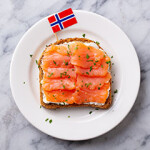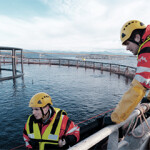Amoebic gill disease likely cause of Salmon Evolution mortalities, forcing cancelation of private placement

The share price of Salmon Evolution dropped sharply on the Oslo Bors stock market after it announced it was dealing with a likely outbreak of amoebic gill disease at its land-based farm in Indre Harøy, Norway.
The company’s shares dropped 10 percent in value on 29 April, to a per-share value of NOK 6.90 (USD 0.65, EUR 0.59), after it said it was experiencing a sudden increase in fish mortalities at its phase-one farm. The share price remained around this level on Wednesday, 10 May.
Just one month after securing a NOK 1.55 billion (USD 147 million, EUR 132 million) green debt financing package to continue scheduled development at its phase-one and phase-two sites at Indre Harøy, and two weeks after completing its latest private placement of shares to raise a further NOK 525 million (USD 49.5 million, EUR 44.9 million), the board of directors decided not to proceed with a subsequent offering of up to 6.5 million new shares on 9 May. It said the decision was made in response to the company’s shares trading for an extended period below the subscription price of NOK 7.7 (USD 0.73, EUR 0.67).
In a statement, Salmon Evolution said that the mortalities occurred in selected fish batches only and ranged from 0.3 percent to 7.9 percent per batch, amounting to 310 metric tons (MT) in total. One subgroup of its batch three group continues to experience increased mortality, along with the smallest fish in one batch four group. The 257,000 fish in batch five, introduced in February 2023, are exhibiting normal feeding patterns and low mortality levels, it said. To ensure year-round availability of harvestable fish, the company introduces salmon into the system in phased batches and grows them in separate tanks.
“The investigation into the root cause for the increased mortality levels continue, but the company has strong indications that amoebic gill disease is the triggering cause,” the company said. “AGD is a common challenge for the conventional salmon farming industry, and there are well-proven treatment methods, namely by using fresh water. The company has, therefore, secured relevant capacities and plans to start freshwater treatment this week with the aim of normalizing the situation, thereby avoiding early harvest of the affected subgroups in batches three and four.”
Norwegian Directorate of Fisheries statistics show that more than 64 million salmon, brown trout, and rainbow trout mortalities occurred in the grow-out phase at sea, against a standing livestock figure of 445 million. This resulted in an average mortality rate of 14.4 percent across the entire country’s aquaculture sector.
At the start of April 2023, Salmon Evolution reported that its production increase was proceeding according to plan and that the company had recorded an all-time high biomass production in March. At the end of the month, the standing biomass was just under 1,500 MT live-weight, having doubled in just 13 weeks. At that time, there were low mortality rates of just 2.2 percent, and harvesting was on schedule to start in early May.
Mortalities notwithstanding, the current biomass of batch two is around 800 MT, with fish weighing an average of four kilograms. These will undergo full harvest by early June. Salmon Evolution plans to introduce five more batches of fish throughout 2023, two of which are due in the second quarter.
“Depending on the future performance of the existing batches and any potential decisions to commence early harvest at suboptimal weights, expected timing for phase-one steady-state production volume may be delayed from late Q3 2023 to late Q4 2023,” a company spokesperson told SeafoodSource.
Salmon Evolution said the market-sized fish from batch two are still likely to generate substantial revenues, as are fish harvested at suboptimal weights.
It concluded its first full harvest in November, finding buyers in Asia, America, and Europe, including Norway, where select retail chains began selling it as “land-based salmon.”
The first phase at Indre Harøy has an annual production capacity of 7,900 MT. Once fully developed, production at the site will be in the region of 31,500 MT head-on gutted (HOG).
By 2032, the company’s ambitious target is to produce 100,000 MT HOG salmon at sites in Norway and around the world. This relies on its hybrid flow-through system technology providing optimal growth conditions and limiting operational and biological risks. Suitable production sites in North America are currently under evaluation, and plans are beginning to start construction at a 16,800 MT HOG facility in South Korea, being developed in a joint venture with Dongwon Industries.
Photo courtesy of Salmon Evolution






Share